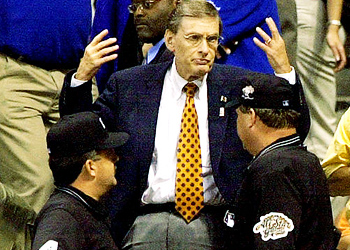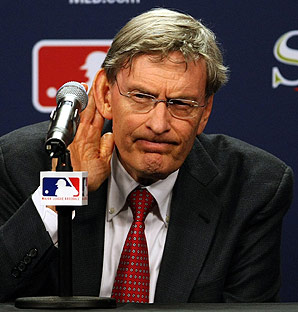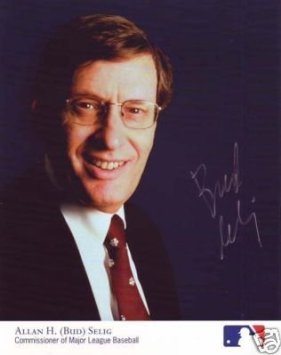So, Bug Selig has retired, and new MLB Commissioner Rob Manfred has already started making his mark. But before we bid farewell to the erstwhile Commish, we need to properly and truly put him into context – the debate has already started about whether or not Bud Selig is likely to gain election into the Hall of Fame when the Expansion Era Committee votes again in 2017. (It’s not an open and shut case…but let’s be real – he’s probably going in.)
But where does he rank when compared with the other array of men to have held the position of Commissioner? How does he stack up in the illustrious history of powerful angry white men appointed by the owners to protect and serve the financial, political, and esoteric interests of their business interests*? How does Selig compare?
*protect the interests of the game of baseball. Sorry, I get them confused.
To do this, we’re going on a historical trip through the commissioners of baseball. For those of you who might be bored by looking at grainy B&W pictures of old dead dudes, tune out now.
Before the Commissioner…
In the time before the first commissioner, Major League Baseball, as we know it today, didn’t quite exist. There were two Major Leagues – the National League, the oldest of the two run by a continually rotating series of OWD (old white dudes), and the American League, the upstart run by Ban Johnson, another OWD. The two leagues had existed semi-harmoniously for quite some time, joining forces in 1903 to create a World Series, and were supervised by a National Commission – the two league presidents and an independent chairman. This body was dominated by the mercurial Johnson for years…until 1919.
That year, the Chicago Black Sox threw the World Series. (You can read about that here) In its wake, the National League thought long and hard about seizing power and running away from the American League. The AL, scared, turned to the commission to try and preserve the baseball union. After much hand wringing, they agreed to reform baseball leadership. It’s important to remember this: the Commissioner of Baseball was a position created to serve the owners’ interests.
Kenesaw Mountain Landis (1920 – 1944)
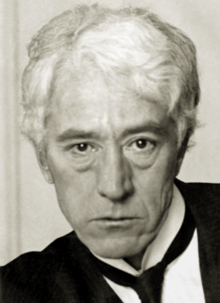 The owners approached an independent, non-owner to be the new Commission’s chairman. Landis looked at the situation and said he would take the position only if he was granted ‘absolute power’, as well as a ‘lifetime contract’. The owners, in real danger of having professional baseball collapse, agreed. Landis promptly made his mark by banning for life the eight players associated with the Black Sox scandal.
The owners approached an independent, non-owner to be the new Commission’s chairman. Landis looked at the situation and said he would take the position only if he was granted ‘absolute power’, as well as a ‘lifetime contract’. The owners, in real danger of having professional baseball collapse, agreed. Landis promptly made his mark by banning for life the eight players associated with the Black Sox scandal.
Landis did clean up baseball – one of his prime missions was to put a stamp on ‘rampant hooliganism’ amongst the players. He had the good taste to postpone baseball during WWI, and kept it running when requested to do so during WWII. He also maintained the ‘reserve clause’, which barred players from free agency, and he upheld baseball’s long-held color line. It’s been argued that Landis would not have stopped Branch Rickey from signing Jackie Robinson, but his actions beforehand show no indication that he had made any efforts towards the signing of black players. (Or Mexican, Cuban, Dominican, Puerto Rican, etc…)
Two things before we move on:
1) Landis was born in 1866. He’d been appointed a Federal judge by Teddy Roosevelt. He was literally the product of an entirely different generation, and had grown up with different ideas and views on race than might traditionally be thought acceptable.
2) Those views are still terrible, wrong, and do not excuse his being an accomplice to baseball’s true black eye. A wrong is still a wrong, even if it’s a politically expedient wrong at the time.
So, yes, Landis was a crotchety old racist.*
*Elected to the Hall of Fame in 1944.
Happy Chandler (1945 – 1951)
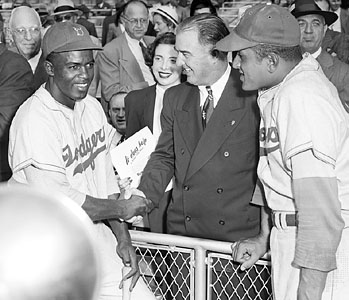 Happy Chandler was a Senator from Kentucky who was lobbied to be selected as Landis’s heir by an official in the War Department. Upon election, he helped to oversee the integration of baseball, supporting Branch Rickey and Jackie Robinson in 1947. Coincidentally, when the owners decided to do away with the ‘lifetime contract’, they did not elect Happy Chandler to a second term. This concludes the segment about the best of baseball’s commissioners.*
Happy Chandler was a Senator from Kentucky who was lobbied to be selected as Landis’s heir by an official in the War Department. Upon election, he helped to oversee the integration of baseball, supporting Branch Rickey and Jackie Robinson in 1947. Coincidentally, when the owners decided to do away with the ‘lifetime contract’, they did not elect Happy Chandler to a second term. This concludes the segment about the best of baseball’s commissioners.*
*Who was elected to the Hall in 1982
Ford Frick (1951 – 1965)
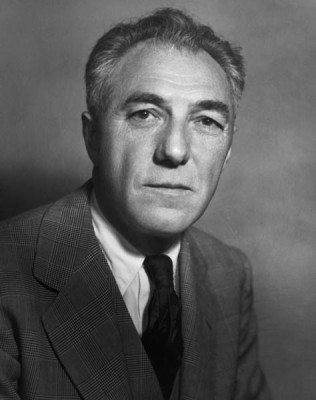 Any time you see an asterisk used in conjunction with a sports record, indicating that the record was tarnished or achieved without merit, you can blame this guy. Babe Ruth’s ex-ghost writer, Frick supported a notion that Roger Maris’s single season home run record should have an asterisk because he accomplished it over eight more games than Ruth did, so as not to offend Ruth’s posthumous sensibilities. That says everything you need to know about Ford “the Prick” Frick.*
Any time you see an asterisk used in conjunction with a sports record, indicating that the record was tarnished or achieved without merit, you can blame this guy. Babe Ruth’s ex-ghost writer, Frick supported a notion that Roger Maris’s single season home run record should have an asterisk because he accomplished it over eight more games than Ruth did, so as not to offend Ruth’s posthumous sensibilities. That says everything you need to know about Ford “the Prick” Frick.*
*Elected to the Hall in 1970
William Eckert (1965 – 1968)
When he was elected to become commissioner of baseball in 1965, Eckert hadn’t been to a game in 10 years. He was fired three years later for lacking the wherewithal to handle growing labor strife with the players. He also apparently refused to cancel games in the wake of MLK Jr’s assassination – whether through malice or incompetence remains unclear.*
*Mr. Eckert is not in the Hall of Fame. Truthfully, I didn’t know he existed until I researched this piece.
Bowie Kuhn (1968 – 1984)
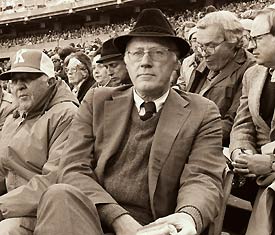 Kuhn fought with the players more than any other commissioner. He took Curt Flood to court for fighting the reserve clause. He instituted a War on Drugs before the War on Drugs was even a thing. He ultimately lost the reserve clause when Marvin Miller and the players union fought back and won the rights to free agency in arbitration in 1975. He banned Mickey Mantle and Willie Mays from baseball from having the audacity to own casinos after their retirement. He was, in short, slightly out of touch throughout his entire time as commissioner, but he made ownership a ton of money. Case in point: in the early 1970’s, baseball writers wanted to honor Negro League players in the Hall of Fame. The HoF administration did not. Mr. Kuhn came up with the breathtakingly genius compromise of creating a separate (but equal) exhibit in the hall for Negro League stars.
Kuhn fought with the players more than any other commissioner. He took Curt Flood to court for fighting the reserve clause. He instituted a War on Drugs before the War on Drugs was even a thing. He ultimately lost the reserve clause when Marvin Miller and the players union fought back and won the rights to free agency in arbitration in 1975. He banned Mickey Mantle and Willie Mays from baseball from having the audacity to own casinos after their retirement. He was, in short, slightly out of touch throughout his entire time as commissioner, but he made ownership a ton of money. Case in point: in the early 1970’s, baseball writers wanted to honor Negro League players in the Hall of Fame. The HoF administration did not. Mr. Kuhn came up with the breathtakingly genius compromise of creating a separate (but equal) exhibit in the hall for Negro League stars.
To wit, he was elected to the Hall of Fame in 2008.*
*Before Marvin Miller, who arguably had a greater impact on the game that ANYBODY else over the last fifty years.
Peter Ueberroth (1984 – 1989)
When Ueberroth took office, 21 of 26 MLB teams were losing money. By the time he left, everyone was making money. However, he was also the guy who instituted collusion, or a way for the owners to try and break the player’s union by establishing a conspiracy to not sign free agents of other teams. Consequently, he was forced to step down from his position early.
A. Bartlett Giamatti (1989)
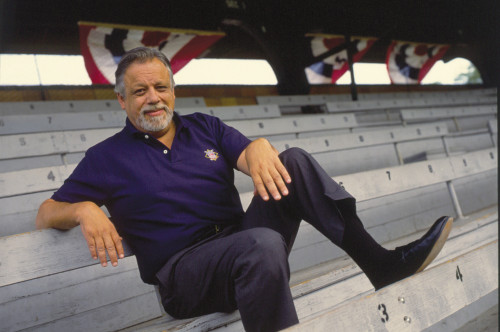 Pay no attention to the love shown him in Ken Burns hagiographical documentary. Giamatti was a company man, right down to holding the line that collusion was a good thing. Indeed, as National League president, he helped to enforce Commisioner Ueberroth’s positions throughout the scandal’s latter days. He also banned Pete Rose for life, which…I’m done. Having said that, he was a lifelong fan of baseball, and – well, he was only commissioner for 154 days before he died of a heart attack. It’s hard to have a major impact in that short a time frame.*
Pay no attention to the love shown him in Ken Burns hagiographical documentary. Giamatti was a company man, right down to holding the line that collusion was a good thing. Indeed, as National League president, he helped to enforce Commisioner Ueberroth’s positions throughout the scandal’s latter days. He also banned Pete Rose for life, which…I’m done. Having said that, he was a lifelong fan of baseball, and – well, he was only commissioner for 154 days before he died of a heart attack. It’s hard to have a major impact in that short a time frame.*
*He was also the father of actor Paul Giamatti. So there is that.
Fay Vincent (1989 – 1992)
Vincent had the unfortunate temerity to get along with neither the players nor the owners, and if you don’t get along with your bosses, your bosses will replace you. Which they did.
Bud Selig
IN SELIG’S FAVOR:
- Expanded revenues by over 400%
- Built new stadiums in over 2/3 of MLB cities (more on that in a second)
- Installed revenue sharing, which instituted something like parity between the haves and have nots of MLB
- Oversaw labor peace…..eventually (we’ll get to that)
- Helped baseball grow and change with the introduction of interleague play and instant replay
- Established the strictest Drug Testing policy of the four major American sports (more on that too)
- Introduced baseball to such meccas of the world as Denver, St. Petersburg, and Miami
AGAINST THE BUD:
- The Players Strike/Lockout of 1994 (labor peace since then, though, guys!)
- Cancelling the God Damned World Series
- Steroids! Steroids! Steroids! (which led to a drug policy!)
- Provided home field advantage to the winner of the All Star Game, which rather than giving meaning to a meaningless game instead puts a competitive advantage in the championship series in the hands of…a meaningless game
- Built stadiums in multiple cities using back-breaking public funds and tax levys…all in the middle of a terrible terrible recession (but new stadiums!)
- Added instant replay and interleague play while not doing away with the Designated Hitter
I made that last one up, although it’s technically true.
So, there you have it. At the end of the day, Bud Selig did some good things, and he did some bad things, which is really no different than most other Hall of Fame players. At his best, he lorded over a renaissance of the game. At his worst, he was a flailing, money-grubbing buffoon who ate hot dogs every day for lunch. Regardless, one can’t argue that baseball is in much better shape today than it was when Selig first took the reins, and he goes out with a positively sparkling image compared to some other figures I could mention.
Happy trails, Bud.
Images courtesy of MLB.com.

